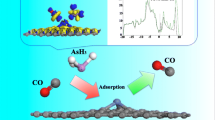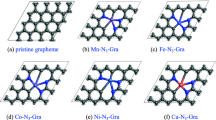Abstract
This work explores the adsorption and dissociation of AsH3 on Ni- and Cu-doped graphene by density functional theory (DFT) method. The most stable configurations, adsorption energy, and dissociation pathways are calculated thoroughly. In addition, the electron density difference (EDD), charge transfer, partial density of states (PDOS), and frontier orbitals are performed to describe the adsorption and dissociation process. The first dehydrogenation step on PG-Cu is easier than on PG-Ni due to the lower energy barrier. But further dissociation is becoming difficult in both systems. The third dehydrogenation steps are the rate determining steps for the whole reactions on PG-Ni and PG-Cu, as the energy barrier is 2.01 and 1.72 eV. In conclusion, PG-Ni and PG-Cu has similar AsH3 sensitivity, but the dissociation of AsH3 on PG-Cu is easier than on PG-Ni. It indicates that PG-Cu has better catalytic activity as an AsH3 removal catalyst than PG-Ni. This work may provide useful information for further experimental studies to develop efficient and long-term AsH3 removal catalysts.

Graphical abstract













Similar content being viewed by others
References
Quinn R, Dahl TA, Toseland BA (2004) An evaluation of synthesis gas contaminants as methanol synthesis catalyst poisons. Appl Catal A-Gen 272(1-2):61–68. https://doi.org/10.1016/j.apcata.2004.05.015
Bhatt BL, Heydorn EC, Tijm PJA, Street BT, Kornosky RM (1999) Liquid phase methanol (LPMEOH (TM)) process development. Abstr Pap Am Chem Soc 217:U241–U241
Hu L, Wang X, Yu G, Wang F, Yu Z (2008) Study of the characteristics of methanol synthesis in a recirculation slurry reactor - a novel three-phase synthesis reactor. Chem Eng Technol 31(1):33–37. https://doi.org/10.1002/ceat.200700081
Lee SG, Sardesai A (2005) Liquid phase methanol and dimethyl ether synthesis from syngas. Top Catal 32(3-4):197–207. https://doi.org/10.1007/s11244-005-2891-8
Quinn R, Mebrahtu T, Dahl TA, Lucrezi FA, Toseland BA (2004) The role of arsine in the deactivation of methanol synthesis catalysts. Appl Catal A Gen 264(1):103–109. https://doi.org/10.1016/j.apcata.2003.12.034
Cayan FN, Pakalapati SR, Celik I, Xu C, Zondlo J (2012) A degradation model for solid oxide fuel cell anodes due to impurities in coal syngas: part I theory and validation. Fuel Cells 12(3):464–473. https://doi.org/10.1002/fuce.201100027
Trembly JP, Gemmen RS, Bayless DJ (2007) The effect of coal syngas containing AsH3 on the performance of SOFCs: investigations into the effect of operational temperature, current density and AsH3 concentration. J Power Sources 171(2):818–825. https://doi.org/10.1016/j.jpowsour.2007.06.087
Lin Y, Wang X, Hao J et al (2017) Improved arsine removal efficiency over MnOx supported molecular sieves catalysts via micro-oxygen oxidation. Energy Fuel 31(9):9752–9759. https://doi.org/10.1021/acs.energyfuels.7b01477
Poulston S, Granite EJ, Pennline HW, Hamilton H, Smith AWJ (2011) Palladium based sorbents for high temperature arsine removal from fuel gas. Fuel 90(10):3118–3121. https://doi.org/10.1016/j.fuel.2011.05.012
Xie Y, Wang L, Ning P et al (2019) Superior activity of Ce-HZSM-5 catalyst for catalytic oxidation of arsine at low oxygen. Appl Organomet Chem 33(3). https://doi.org/10.1002/aoc.4745
Wang X, Huang H, Zhou Q et al (2018) High-performance arsine removal using CuOx/TiO2 sorbents under low-temperature conditions. Energ Fuels 32(6):7035–7045. https://doi.org/10.1021/acs.energyfuels.8b00448
Lin Y, Wang X, Hao J et al (2019) Preparation of CuZnAl hydrotalcite-like catalysts for AsH3 abatement at low temperatures. Catal Commun 118:51–55. https://doi.org/10.1016/j.catcom.2018.03.028
Quinn R, Dahl TA, Diamond BW, Toseland BA (2006) Removal of arsine from synthesis gas using a copper on carbon adsorbent. Ind Eng Chem Res 45:6272–6278. https://doi.org/10.1021/ie060176v
Goharibajestani Z, Yurum A, Yurum Y (2019) Effect of transition metal oxide nanoparticles on gas adsorption properties of graphene nanocomposites. Appl Surf Sci 475:1070–1076. https://doi.org/10.1016/j.apsusc.2019.01.052
Esrafili MD (2018) N2O + CO reaction over a single Si or P atom incorporated nitrogen-doped graphene: a comparative DFT study. Chem Phys Lett 708:94–99. https://doi.org/10.1016/j.cplett.2018.08.006
Tang Y, Cui X, Chen W, Zhu D, Chai H, Dai X (2018) A theoretical study on metal atom-modified BC3 sheets for effects of gas molecule adsorptions. Appl Phys A-Mater 124(6). https://doi.org/10.1007/s00339-018-1855-3
Yuan P-F, Liu H, Sun Q, Jia Y (2018) CO oxidation on Ni doped and Ni-M (M = Ca, Sc, V, Cu) bimetal-doped graphene: a first-principles study. Comput Mater Sci 151:189–195. https://doi.org/10.1016/j.commatsci.2018.04.066
Zhao D, Fan X, Luo Z, An Y, Hu Y (2018) Enhanced gas-sensing performance of graphene by doping transition metal atoms: a first-principles study. Phys Lett A 382(40):2965–2973. https://doi.org/10.1016/j.physleta.2018.06.046
Dong H-K, Wang Y-P, Shi LB (2016) First principles study of HCN adsorption on graphene doped with 5d transition metal. Surf Rev Lett 23(1). https://doi.org/10.1142/s0218625x1550095x
Shi LB, Wang YP, Dong HK (2015) First-principle study of structural, electronic, vibrational and magnetic properties of HCN adsorbed graphene doped with Cr. Mn and Fe Appl Surf Sci 329:330–336. https://doi.org/10.1016/j.apsusc.2014.12.172
Tabtimsai C, Somtua T, Motongsri T, Wanno B (2018) A DFT study of H2CO and HCN adsorptions on 3d, 4d, and 5d transition metal-doped graphene nanosheets. Struct Chem 29(1):147–157. https://doi.org/10.1007/s11224-017-1013-0
Tang Y, Chen W, Li C, Pan L, Dai X, Ma D (2015) Adsorption behavior of Co anchored on graphene sheets toward NO, SO2, NH3. CO and HCN molecules Appl Surf Sci 342:191–199. https://doi.org/10.1016/j.apsusc.2015.03.056
Tang Y, Liu Z, Shen Z, Chen W, Ma D, Dai X (2017) Adsorption sensitivity of metal atom decorated bilayer graphene toward toxic gas molecules (CO, NO, SO2 and HCN). Sensor Actuat B-Chem 238:182–195. https://doi.org/10.1016/j.snb.2016.07.039
Zhao M, Yang F, Xue Y, Xiao D, Guo Y (2014) Adsorption of HCN on reduced graphene oxides: a first-principles study. J Mol Model 20(4). https://doi.org/10.1007/s00894-014-2214-8
Zhou Q, Ju W, Su X et al (2017) Adsorption sensitivity of graphane decorated with B, N, S, and Al towards HCN: a first-principles study. RSC Adv 7(69):43521–43530. https://doi.org/10.1039/c7ra08579f
Bo Z, Guo X, Wei X, Yang H, Yan J, Cen K (2019) Density functional theory calculations of NO2 and H2S adsorption on the group 10 transition metal (Ni, Pd and Pt) decorated graphene. Phys E 109:156–163. https://doi.org/10.1016/j.physe.2019.01.012
Cortés-Arriagada D, Villegas-Escobar N, Ortega DE (2018) Fe-doped graphene nanosheet as an adsorption platform of harmful gas molecules (CO, CO2, SO2 and H2S), and the co-adsorption in O2 environments. Appl Surf Sci 427:227–236. https://doi.org/10.1016/j.apsusc.2017.08.216
Ambrusi RE, Pronsato ME (2019) DFT study of Rh and Ti dimers decorating N-doped pyridinic and pyrrolic graphene for molecular and dissociative hydrogen adsorption. Appl Surf Sci 464:243–254. https://doi.org/10.1016/j.apsusc.2018.09.073
Faye O, Eduok U, Szpunar J, Samoura A, Beye A (2018) H2S adsorption and dissociation on NH-decorated graphene: a first principles study. Surf Sci 668:100–106. https://doi.org/10.1016/j.susc.2017.10.016
Zhang H-p, Luo X-g, Song H-T, Lin X-Y, Lu X, Tang Y (2014) DFT study of adsorption and dissociation behavior of H2S on Fe-doped graphene. Appl Surf Sci 317:511–516. https://doi.org/10.1016/j.apsusc.2014.08.141
Behjatmanesh-Ardakani R (2018) Periodic and non-periodic DFT modeling of CO reduction on the surface of Ni-doped graphene nanosheet. Mol Catal 455:239–249. https://doi.org/10.1016/j.mcat.2018.06.008
Zheng Y, Xiao W, Cho M, Cho K (2013) Density functional theory calculations for the oxygen dissociation on nitrogen and transition metal doped graphenes. Chem Phys Lett 586:104–107. https://doi.org/10.1016/j.cplett.2013.09.016
Li Y, Sun X, Zhou L, Ning P, Tang L (2019) Density functional theory analysis of selective adsorption of AsH3 on transition metal-doped graphene. J Mol Model 25(5):145. https://doi.org/10.1007/s00894-019-3991-x
Ernzerhof M, Scuseria GE (1999) Assessment of the Perdew-Burke-Ernzerhof exchange-correlation functional. J Chem Phys 110(11):5029–5036. https://doi.org/10.1063/1.478401
Hammer B, Hansen LB, Norskov JK (1999) Improved adsorption energetics within density-functional theory using revised Perdew-Burke-Ernzerhof functionals. Phys Rev B 59(11):7413–7421. https://doi.org/10.1103/PhysRevB.59.7413
Cha J, Sung D, Min K-A, Hong S (2018) Van der Waals density functional theory study of molecular adsorbates on MoX2(X = S, Se or Te). J Korean Phys Soc 73(1):100–104. https://doi.org/10.3938/jkps.73.100
He Y, Yu J, Wu H, Jia J (2019) Defining the optimal morphology of Rh-n nanoparticles for efficient hydrazine adsorption: a DFT-D3 study. J Mater Sci 54(13):9533–9542. https://doi.org/10.1007/s10853-019-03579-5
Liao Y, Gao Z, Yang W, Zhong J, Ding Y (2019) Weak interaction between water molecule and different rank coals: a DFT-D3 study. Int J Oil Gas Coal T 21(1):91–108. https://doi.org/10.1504/ijogct.2019.099519
Petrushenko IK, Petrushenko KB (2018) DFT study of single-walled carbon hollows as media for hydrogen storage. Comput Theor Chem 1140:80–85. https://doi.org/10.1016/j.comptc.2018.08.001
Pilar de Lara-Castells M, Cabrillo C, Micha DA, Mitrushchenkov AO, Vazhappilly T (2018) Ab initio design of light absorption through silver atomic cluster decoration of TiO2. Phys Chem Chem Phys 20(28):19110–19119. https://doi.org/10.1039/c8cp02853b
Samanta PN, Das KK (2019) Deciphering the impact of surface defects and functionalization on the binding strength and electronic properties of graphene-polypyrrole nanocomposites: a first-principles approach. J Phys Chem C 123(9):5447–5459. https://doi.org/10.1021/acs.jpcc.8b11173
Chen D, Zhang X, Tang J, Fang J, Li Y, Liu H (2018) Adsorption and dissociation mechanism of SO2 and H2S on Pt decorated graphene-a DFT-D3 study. Appl Phys A Mater Sci Process 124:404. https://doi.org/10.1007/s00339-018-1827-7
Funding
This work was supported by the National Natural Science Foundation of China [51708266] and the research fund program of Guangdong Provincial Key Laboratory of Environmental Pollution Control and Remediation Technology [2018K23].
Author information
Authors and Affiliations
Corresponding author
Additional information
Publisher’s note
Springer Nature remains neutral with regard to jurisdictional claims in published maps and institutional affiliations.
Electronic supplementary material
Table S1
(DOCX 43 kb)
Rights and permissions
About this article
Cite this article
Li, Y., Li, K., Sun, X. et al. DFT calculation of AsH3 adsorption and dissociation on Ni- and Cu-doped graphene. J Mol Model 25, 358 (2019). https://doi.org/10.1007/s00894-019-4227-9
Received:
Accepted:
Published:
DOI: https://doi.org/10.1007/s00894-019-4227-9




